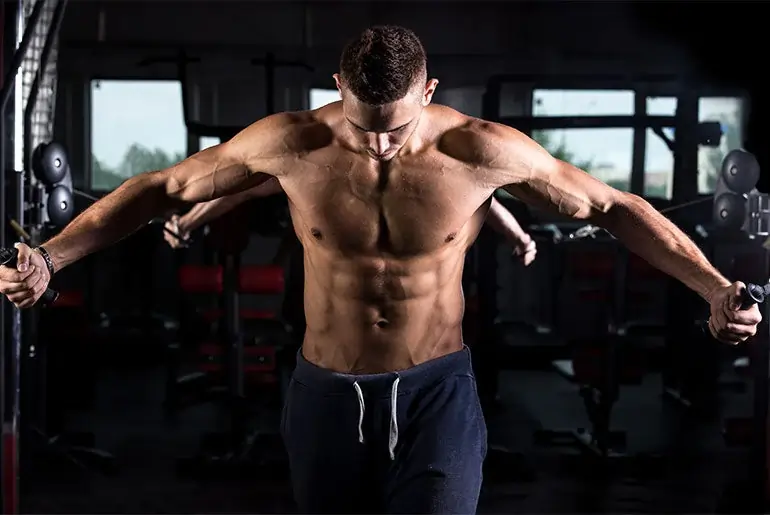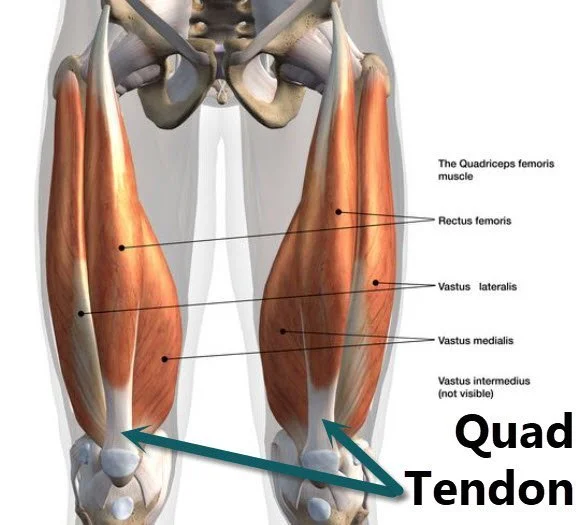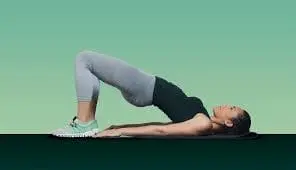12 Best Workouts for Upper Chest
The upper chest, primarily targeted by the clavicular head of the pectoralis major, plays a key role in achieving a fuller, more defined chest. Strengthening the upper chest improves upper body performance and symmetry. Effective upper chest workouts typically involve incline angles to better activate the upper pec fibers.
Introduction:
Many people overlook the significance of the upper chest in favor of concentrating mostly on the lower part when trying to develop an amazing chest. However, working on both the upper and lower areas is necessary to achieve a well-rounded chest.
Targeted exercise is necessary to develop a well-rounded chest, and the upper chest is frequently the most ignored area. To properly activate the upper pectoral muscles, particularly the clavicular head of the pectoralis major, certain angles and motions are required.
The dumbbell incline bench press performed with dumbbells rather than an incline barbell is an essential component of most effective upper chest training regimens. However, here is an excellent description of an upper chest workout that utilizes some, but not all, of that range of motion.
Benefits of exercise:
Here is a thorough explanation of the advantages of upper chest workouts, showing you why it’s essential to include them in your fitness regimen for strength, posture, and performance in addition to appearance.
A better physical appearance
A powerful upper chest:
- Improves the appearance of the upper part of the body by making the chest appear more defined and elevated.
- Gives the neck and shoulders a more defined appearance.
- Helps achieve the desirable “square chest” or look in bodybuilding.
Balanced Development of the Chest
Many lifters place too much focus on flat bench pressing, which can result in a lower or mid-chest that is abnormally developed. It helps to train the upper chest:
- Make your chest more shaped and powerful.
- Avoid the “droopy chest” appearance, which is characterized by a lack of thickness in the upper chest.
- Improve the balance of your chest overall.
Improved Posture and Shoulder Stability
Muscle imbalances caused by ignoring the upper chest can result in:
- Rounded shoulders.
- Upper-crossed syndrome.
- Bad posture.
- By supporting the shoulder girdle, upper chest training improves position and lowers the chance of strain or injury.
Strengthening of the Upper Body
Exercises for the upper chest strengthen the pectoralis major’s clavicular head, which improves performance in:
- Overhead presses.
- Incline pushing movements.
- Functional activities, such as raising objects above the shoulder.
Improved Sports Performance
A well-developed upper chest is beneficial for athletes, particularly those participating in pushing or throwing sports:
- Increases the power of the upper body.
- Improves athletic performance in sports such as martial arts, basketball, boxing, swimming, and football.
- Facilitates more rapid and focused arm motions.
Better Mind-Muscle Communication and Muscle Activation
Concentrating on individual workouts for the upper chest:
- Improves your neuromuscular coordination.
- Improves technique and activation in all chest actions by strengthening the connection between your brain and muscles.
Preventing Injuries
When properly performed, upper chest exercises:
- When performing pushing exercises, lessen the strain on the shoulders, reducing wear and tear.
- Reduce your risk of rotator cuff problems when working out your upper body.
Strength in Function for Daily Life
Upper chest strength is necessary for tasks like pushing open heavy doors, carrying overhead loads, and lifting objects to a shelf. In this area:
- Makes the upper body more functional.
- Makes routine physical labor safer and easier.
Encourages the Growth of the Whole Chest
Working out the entire chest, but particularly the upper portion, ensures:
- Consistent muscle growth, or hypertrophy
- Improved pump and blood flow
- Maximum chest fiber activation
Variety and the Advancement of Exercise
- Interrupts the exercising regimen on a flat bench.
- Hits the muscles from different angles, which helps in breaking through levels.
- Continuously builds muscle by adding new growth factors.
Workouts for Upper Chest:
Your chest programs might incorporate exercises with dumbbells, bodyweight, cables, and resistance bands for the upper chest.
Incline Smith Machine Press
- Set the bench’s inclination between 30° and 45° (30° is ideal for upper chest concentration).
- The bar should be parallel to the top of your chest when you are lying on the bench.
- Lean back on the bench and put your feet firmly on the floor.
- Use a grip that is just a little bit wider than shoulder-width.
- To release the bar from the safety hooks, rotate it.
- Start by fully extending your arms without locking your elbows.
- Breathe in while lowering the bar gradually and carefully.
- Place it directly behind the collarbone or on the upper chest.
- As you raise the bar back to the beginning position, release your breath.
- Then return to your neutral position.
- Then relax.
- Repeat these exercises 5 to 10 times.
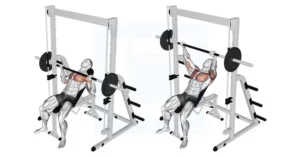
Bodyweight dip
- Look for a dip station or parallel bars.
- Take a strong, neutral grip on the handles.
- As you raise your body into the starting posture, extend your arms in front of you.
- Make sure your upper body is 30 to 45 degrees up.
- Look down with your chin slightly tucked in.
- Your elbows should remain slightly bent.
- Breathe deeply and progressively lower your body while maintaining a consistent lean angle.
- Your chest should drop to your hands.
- Feel the shoulders and chest getting stretched.
- Use your palms to raise your body back up after you’ve exhaled.
- During the workout, maintain your chest engaged and push forward.
- Then return to your neutral position.
- Then relax.
- Repeat these exercises 5 to 10 times.

Incline pushup
- Locate a stable raised platform, such as a bar, step, box, or bench.
- The difficulty of the push-up increases with decreasing inclination (greater inclines are simpler).
- Lay your hands on the surface shoulder-width apart.
- Stretch your legs behind you until your head and heels are in a straight line.
- Breathe in as you work your chest down to the raised surface.
- Your elbows should extend from your sides at a 45° angle or so.
- Don’t decrease or raise your head; instead, keep it in a neutral position.
- To get back to the beginning position, release your breath and push through your palms.
- Then return to your neutral position.
- Then relax.
- Repeat these exercises 5 to 10 times.
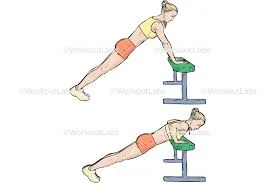
Decline push up
- Choose a sturdy elevated platform, like a bench or box.
- Place your hands on the ground and your feet on the raised platform.
- Avoid letting your elbows extend out too much and maintain control of them.
- Drop as low as you can without compromising form, or until your chest is just over the floor.
- With your arms fully extended, push yourself back up to the beginning position.
- Your upper chest should be squeezed as you push up.
- Then return to your neutral position.
- Then relax.
- Repeat these exercises 5 to 10 times.
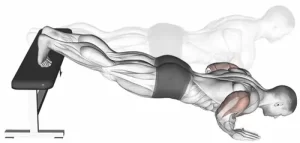
Incline Dumbbell Fly
- A 30 to 45° incline should be set for your bench.
- Hold a pair of dumbbells that are light to moderate in weight.
- With your palms facing each other, press the dumbbells straight up while lying back on the bench.
- Keep your elbows slightly bent during the entire workout.
- Pull your shoulder blades down and back to protect your shoulders and focus your chest.
- Inhale and slowly lower the weights outward in a wide circle, keeping elbows slightly bent.
- Lower yourself until your elbows are parallel to the ground or your chest feels deeply stretched.
- Before the stress moves to the shoulders, stop using the dumbbells before they are too low.
- Return the dumbbells to their initial position by exhaling and squeezing your chest.
- Instead of pressing, maintain the arc broad, like you would when hugging a large tree.
- Then return to your neutral position.
- Then relax.
- Repeat these exercises 5 to 10 times.
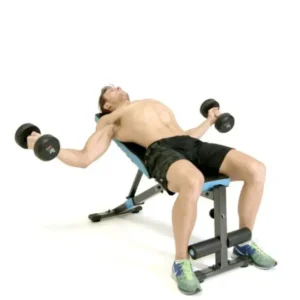
Cable crossover
- Make use of a dual-adjustable pulley system.
- Put both pulleys in the lowest position possible.
- On either side, fasten the handle grips.
- Move forward while standing in the center to lengthen the cables.
- One foot should be placed slightly ahead of the other for balance.
- Hold onto the grips with your palms facing up or slightly inward.
- Your elbows should remain slightly bent.
- Maintain a raised chest and back shoulders.
- Take a breath, then release it as you pull the handles across your body and upward toward a point in front of your upper chest.
- When your hands meet or slightly cross at the top of the action, squeeze your chest.
- Keeping control and the chest stretch, take a breath and slowly return the wires to the beginning position.
- Then return to your neutral position.
- Then relax.
- Repeat these exercises 5 to 10 times.
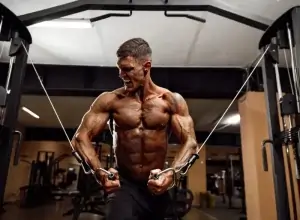
Incline Barbell Bench Press
- Set the incline bench between 30° and 45°.
- Hold the barbell with a little broader grip than shoulder-width while lying back.
- Shoulder blades pulled back and down, back slightly arched, feet flat on the ground.
- Eyes that are racked right beneath the bar.
- Take a deep breath, tense your abdominal muscles, and raise the bar off the rack until it is above your upper chest.
- Lower the bar gradually to the region of your upper chest and collarbones, which is around the top of your sternum.
- Your elbows should not be splayed out; they should be at a 45° angle from your sides.
- Lift the bar in a gentle pulling motion until your arms are nearly locked out.
- Then release your breath.
- On top, squeeze your chest.
- Then return to your neutral position.
- Then relax.
- Repeat these exercises 5 to 10 times.
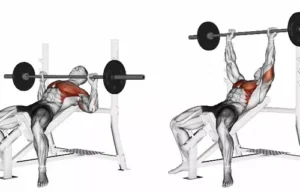
Overhead press
- Start with standing position on the ground.
- Place them palms up at shoulder height to begin.
- Maintain a firm core, active glutes, and a little raised chest.
- Look ahead.
- After taking a breath, push the dumbbells up and back a little, ending over the top of your head.
- At the beginning, the elbows should be slightly forward rather than stretched out to the sides.
- Do not overarch; maintain a straight stance.
- Then return to your neutral position.
- Then relax.
- Repeat these exercises 5 to 10 times.
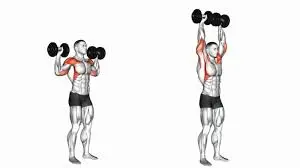
Incline Dumbbell Press
- The bench should be adjusted to a 30° to 45° incline.
- Hold a dumbbell in each hand and place them on your thighs while you sit back.
- As you lie back with your palms facing forward, lift the dumbbells to shoulder height.
- Take a breath and raise the dumbbells above your upper chest, keeping them slightly together.
- Instead of being splayed out wide, your elbows should be at a 45° angle to your upper body.
- As you press, exhale.
- Feel a deep stretch in your upper chest as you progressively lower them to just below shoulder height.
- Then return to your neutral position.
- Then relax.
- Repeat these exercises 5 to 10 times.
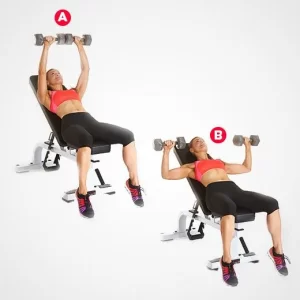
Wide-Grip Bench Press
- For a focus on the upper chest, choose an inclination (30° to 45°) or a flat chest overall.
- Hold the bar with your hands.
- The index fingers are frequently on or close to the outer rings of the bar.
- With your feet flat, shoulders back, and your lower back slightly arched, lie down.
- Lift the bar off the rack by taking a deep breath and contracting your abdominal muscles.
- If you’re utilizing an inclined bench, place it over your upper chest/collarbone region.
- For an incline, slowly lower the bar to just below the collarbone in the upper chest.
- Make sure your elbows are 75 to 90 degrees out from your body.
- The bar should be pushed back and raised a little.
- Squeeze your chest and release the breath at the top.
- Then return to your neutral position.
- Then relax.
- Repeat these exercises 5 to 10 times.
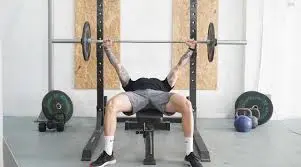
Bent-over row
- Start with standing position on the ground.
- Hold dumbells in your both hands.
- Maintaining a flat back and body angle at 45° or less, flexing at the hips.
- With your hands facing your body, let the dumbbells hang at arm’s length.
- Keeping your elbows close to your body, pull the dumbbells toward your waist or lower chest.
- The top of your shoulder blades should be squeezed.
- Return the dumbbells to their initial position gradually.
- Hold this position for a few seconds.
- Then return to your neutral position.
- Then relax.
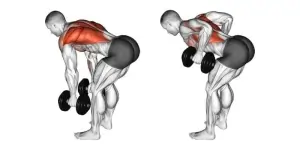
Guillotine press
- A flat bench will provide a more stable press.
- The upper chest will be targeted with this broad grasp.
- Lay flat on the bench with your eyes directly below the bar.
- Maintain a modest elevation of your chest and make sure the arch of your lower back is natural rather than too arched.
- Maintaining a straight wrist position, raise the bar just above your neck.
- With control, slowly drop the barbell toward your neck or upper chest.
- Make sure your elbows are set up at a broad angle by extending them out.
- To fully engage your upper chest, have your elbows bent just slightly.
- With an intended motion, raise the barbell back up once it is just above your neck (or upper chest).
- To maintain tension, make sure you’re not locking out your elbows at the top and concentrate on squeezing your chest as you press.
- To prevent putting too much tension on your neck and shoulder joints, move carefully.
- Then return to your neutral position.
- Then relax.
- Repeat these exercises 5 to 10 times.
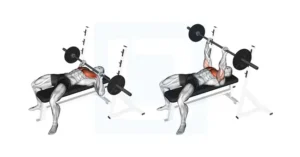
What safety measures need to be taken when working out?
If done incorrectly, upper chest exercises, particularly those that use high weights and incline presses, can strain your shoulders, joints, and spine. To avoid injuries and guarantee successful training, you ought to pay attention to some important safety precautions.
Get Well Warmed Up
Cold muscles are prone to damage.
- Do light cardio for five to ten minutes (e.g., jumping jacks, treadmill).
- Do dynamic stretches that target the rotator cuff, shoulders, and chest.
- Before moving into heavier resistance, use mild resistance for one or two warm-up sets.
Make Use of the Proper Incline Angle
Tension is transferred to the shoulders at angles greater than 45°.
- For the best upper chest activation, adjust the bench’s angle between 30 and 45 degrees.
- Aside from purposefully targeting shoulders, be clear of really steep inclines.
Pay Attention to Form, Not Just Weight
Bad form lowers muscle activation and raises the chance of injury.
- Move with control rather than bouncing the bar off your chest.
Pay Attention to Your Shoulders
Shoulder engagement is increased by inclined angles.
- Use prehab activities to strengthen your rotator cuff muscles.
- When working out back-to-back, avoid overtraining your upper chest and shoulders.
- When performing presses, keep your shoulders retracted rather than shrugging them up.
Make Use of Safety Equipment or a Supervisor
To prevent becoming stuck or pinned by the weight.
- Barbell incline presses should never be performed without a supervisor’s help.
- Use a Smith machine or install safety bars in a power rack if you’re training alone.
Avoid Locking Out Your Elbows
Locking out might ease chest tension and strain your elbow joints.
- At the height of the action, press the weight up, but do not lock out.
- This keeps the chest tense all the time.
Use the Right Breathing Methods
- As you fall (eccentric phase), inhale.
- Press up and exhale (concentric phase).
Select the Right Weight
Lifting too much weight might cause form problems and raise the risk of injury.
- For 8–10 repetitions, start with a reasonable weight that you can manage.
- Increase weight gradually only once you can keep your form correct.
After working out, stretch and cool down.
Makes you more flexible and less sore.
- Spend 5 to 10 minutes stretching your shoulders, triceps, and chest.
- To relieve stress in the upper back and chest, use foam rolling.
Don’t Overtrain
Muscles grow as they heal, not when they workout.
- Allow a minimum of 48 hours between chest sessions.
- Pay attention to your body; if you experience pain rather than pain, stop right away.
When Is It Time to Stop Working Out?
Avoiding injury, overtraining, and exhaustion during an upper chest workout requires knowing when to quit. Listening to your body is essential for long-term success, yet many people push themselves too hard in their attempt to gain.
This comprehensive instruction explains when to quit exercising, particularly while doing upper chest workouts.
When Your Form Becomes Unsuitable
Injuries to the shoulder, elbow, and chest are more likely to happen with poor form.
Warning Signs to Stop:
- You’re lifting the weight using force.
- You’re rolling forward or shrugging your shoulders.
- The dumbbells or bars move too much.
When You Experience Unusual Fatigue or Lightheadedness
Warning Signs to Stop:
- You feel lightheaded or unstable.
- For a long time, your heart rate is abnormally elevated.
- You experience nausea or confusion.
When Muscle Failure Has Happened
Giving each workout your all might result in overtraining and exhaustion.
Warning Signs to Stop:
- You are physically incapable of performing another rep with proper form.
- Your muscles are unstable or utterly worn out.
When You Experience Sudden or Sharp Pain
A strain or tear may be indicated by sharp pain, particularly in the shoulder or chest.
Warning Signs to Stop:
- A sudden “pop” or tearing sound
- Joint or tendon burning pain
- Pain radiating down your neck or arm
When Your Performance Declines Noticeably
When your performance declines, it’s usually a sign that your body has had enough for the day.
Warning Signs to Stop:
- You are unable to lift weights that you previously handled with ease.
- Even with enough rest, the number of repetitions decreases significantly with each set.
When Your Mind Is Cleared Out
Mental exhaustion impairs concentration and raises the risk of damage.
Warning Signs to Stop:
- You’re distracted or hurrying through sets.
- Mid-workout, you’ve lost motivation.
Summary:
Finally, a strong and muscular upper chest is necessary for a well-rounded and beautiful appearance. There are numerous upper chest exercises and methods you can use to efficiently target your upper chest muscles and achieve your fitness goals, whether you’re working out at home or in a gym.
When combined with full chest training, concentrating on your upper chest can significantly improve the overall balance and shape of your chest. Your upper pectorals will start to show more strength and definition if you combine pressing and fly movements at the proper incline degrees.
But doing an upper chest workout at home is also a good choice, particularly for people who might not have access to a gym or who would rather work out in the comfort of their own home. Push-ups, incline push-ups, and dips are examples of bodyweight exercises that can be readily adjusted to fit your fitness level and are equally effective at targeting the muscles in your upper chest.
The foundations of muscular development are form, progressive loading, and stability. If you train wisely and consistently, you’ll see results.
FAQ:
How frequently should I work out my upper chest?
Training your chest should ideally be done once or twice a week, with at least one session devoted to upper chest exercises. In order to allow for muscle growth and recovery, avoid training on the same day.
Is it possible to work only the upper chest without strengthening the rest of the chest?
The upper chest can be highlighted, although total isolation is not achievable. All parts of the pecs are slightly activated by the majority of chest exercises. In contrast to flat or decline motions, incline movements considerably increase upper chest activation.
Are the upper chest muscles worked by push-ups?
Normal push-ups focus mostly on the mid and lower chest. Try feet-elevated push-ups, also known as decline push-ups, to strengthen your upper chest. The angle simulates an uphill press by shifting strain upward.
For building my upper chest, should I use dumbbells or barbells?
Each has benefits:
With barbells, you may increase your strength and lift heavier weights.
Dumbbells offer a greater range of motion and help in dealing with muscular imbalances. Both balance and strength work best together.
What are the finest upper-chest exercises for newcomers?
Compared to barbells, the inclined dumbbell press is easier to handle.
Fly from low to high cable
Smith machine press with an incline
Bodyweight, foot-elevated push-ups that can be done at home
Does the growth of the upper chest need fly movements?
Fly exercises that isolate and stretch the upper chest, such as low-to-high cable flies or incline dumbbell flies, help in the promotion of hypertrophy. Although they are not required, they are great for:
Definition of muscles
Increased flexibility
Performing a targeted chest pump to wrap out your exercise
Can I use no equipment to grow my upper chest at home?
In fact, with differences in bodyweight: Decline push-upsIncline pike push-ups Resistance bands for flys or incline presses Regularity and effort can still produce benefits, even when resistance is less than with gym equipment.
What contrasts an incline dumbbell press from an incline barbell press?
Barbell Press With Incline: allows for greater stability and heavier lifting.
The Incline Dumbbell Press can help correct muscle imbalances, increase range of motion, and stimulate stabilizing muscles. They can be utilized in the same session or rotated weekly, and both are great.
How much time does it take to notice changes in the upper chest?
In six to eight weeks, visible modifications can be observed with proper exercise, diet, and recovery. However, depending on genetics, regularity, and exercise intensity, full development could take several months.
References:
- Cscs, Cscs: The Greatest Upper Chest Workout | 8 Upper Chest Exercises | 2024
- Barbell Medicine’s Top 6 Upper Chest Exercises for Greater PECs in 2024
- Richter’s Top 10 Upper Chest Exercises for Effective PECs in 2024
- The Complete Guide to Upper Chest Exercises, 2025 – Shashi
- Wuebben’s Top Upper-Chest Exercise for Developing Defined Pecs in 2024
- The top five chest exercises for every chest workout in 2025 Kirkup-Lee
- Usaw-L is one of the top nine upper chest workouts for stronger PECs in 2024.
- Chest exercises at home, 2025 Cscs, Cscs
- Workout for the chest | 5 Upper Chest Exercises – MYPROTEINTM – 2018 – Dawes
- 11 upper chest exercise suggestions for 2024
- Image 1, The 2023 Lift Manual: Smith Incline Bench Press Guide, Benefits, and Form
- Image 5, Dumbbell fly in an inclined position
- Image 6, 2024 Incline Bench Press | myUpchar
- Image 7, The proper way to perform the 2023 Storm overhead dumbbell press
- Image 9, Learn the advantages and correct form of the wide grip bench press by Stefanov in 2022.
- Image 12, Guide, Advantages, and Form for the Barbell Guillotine Bench Press – 2023 Lift Manual

